HP EliteBook 8760w: Color, So Dreamy
by Dustin Sklavos on August 25, 2011 2:30 AM ESTBattery, Noise, and Heat
Unfortunately, one place where the HP EliteBook 8760w falls majorly short is battery life. The NVIDIA Quadro 5010M is fast, but it also sucks down a lot of power and HP doesn't support Optimus switching technology with this particular unit. That means you're on the dedicated GPU all of the time, and the Quadro 5010M appears to use around 15 to 20W minimum—about double the rest of the notebook!
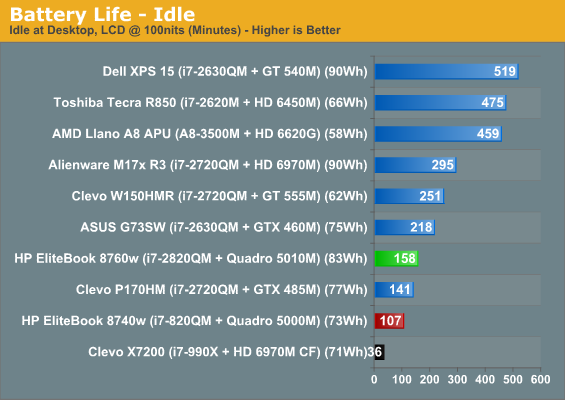
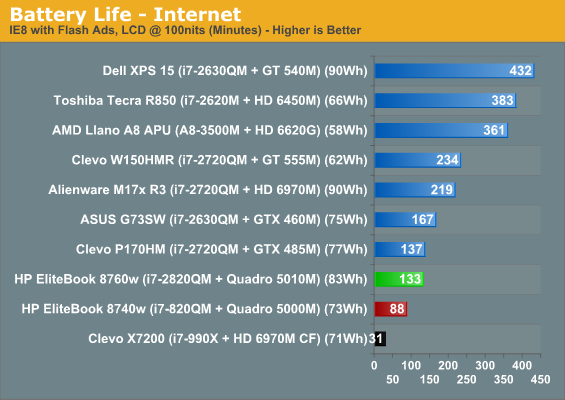

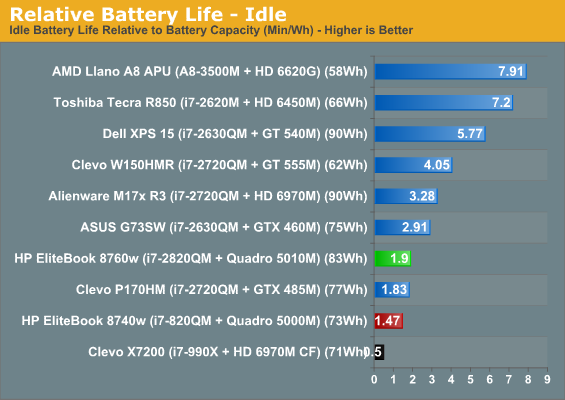
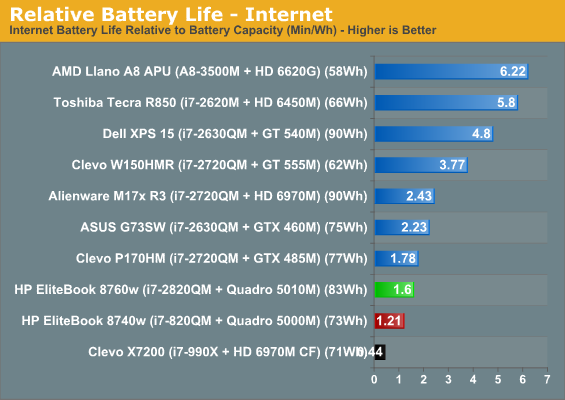
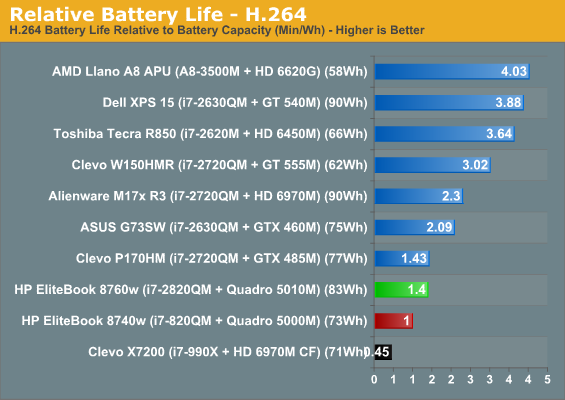
Between the bigger battery and Sandy Bridge's improved power consumption, the 8760w is at least able to put in a decent showing compared to its predecessor, but it absolutely languishes behind the other notebooks tested, with only the X7200 and its 300 watts worth of CPU and GPU horsepower performing worse. HP is probably betting most users aren't liable to run the 8760w off the mains, but even a muxed graphics switching system wouldn't go unappreciated.

Thermals and noise on the EliteBook 8760w aren't great, but they aren't terrible either. Temperature-wise, the Quadro 5010M actually remains remarkably cool under load, but the i7-2820QM creeps over 90C, suggesting the potential for turbo to throttle the cores somewhat due to heat.
Under heavy load you'll definitely hear the fan spin up, though. It's a low whoosh as opposed to a high whine, but the high performance components of the 8760w definitely make their presence known when the system is being stressed.










83 Comments
View All Comments
aranyagag - Thursday, August 25, 2011 - link
yeah I was planning to get a 17" DTR with sandybridge-- all was fine and dandy till I Got to the specifications for the screen. Sorry, but I want a 1200p screen. even when I watch videos-- which is rare because I prefer to watch on home theater and use my laptop for work-- I PREFER to have space above/below the screen for the menu bar.Well, I am waiting for the 1200p screens to return and if they don't -- I will eventually settle for a 15.6" 1080p screen. I just am not buying a 17" or larger laptop with only 1080p screen.
oshogg - Thursday, August 25, 2011 - link
17" is a little too big for my taste - I would appreciate a similar in-depth review (great job on this one by the way!) for HP 8560w. Specifically, I am interested in knowing that Quadro 1000M is any less taxing on battery than the one in 8760w.Thanks,
Osho
teng029 - Thursday, August 25, 2011 - link
certainly a much better design than Dell's current Latitude line. i've tried carrying a 17.3 inch notebook before and didn't particularly care for it. and like so many other posters have mentioned, i still prefer 16x10 panels.Spazweasel - Thursday, August 25, 2011 - link
As always, computers of this class are something your employer buys you. Individuals are not likely to pay for items like this, but organizations whose cost-accounting recognizes that the hardware is a small fraction of the cost of maintaining an employee are not going to be put off by a thousand dollar premium. Compared to the software packages that enterprises use, the amortized cost of support and infrastructure, and the salaries of the people that use them, six thousand in hardware is chump change.Buy this one with someone else's money, not your own, and you (and they) get the value expected for something this expensive.
jecs - Friday, August 26, 2011 - link
Thank you, That was what I had in mind for years, but still something I wanted to check over time. I worked for BP years ago and sure they provided fancy hardware and software even for contractors. I remember a Silicon Graphics computer on a corner and it was only used for an advanced student on one study. Today this HP laptop is way too superior but computing requirements may also increase with time.Death666Angel - Thursday, August 25, 2011 - link
I really don't see how the desktop space has somehow "lost" 30" monitors almost entirely. From my experience over the past years, the 30" crowd has been very stable. The 27" high-res didn't destroy anything and gave people a cheap middle ground between cheap 24" 1200p and overpriced 1600p 30" monitors. I think 27" 2560x1440 has been about the only positive development in the desktop monitor market for a long time, partially making up for the move to 1080p in the 21"-27" market.I personally hope the tablet/smartphone display development with high densities will transfer to the desktop market soon.
Dustin Sklavos - Thursday, August 25, 2011 - link
From a conversation with my associate, Brian Klug (who handles our monitor reviews), 30" screens are being phased out of production entirely.zaccun - Thursday, August 25, 2011 - link
Thank god I've already got one then- That almost makes me want to save up and buy a couple more to hoard :<DanNeely - Friday, August 26, 2011 - link
Gah!!! Like zaccun I'm tempted to go after a spare. If the replacement was 2844x1600 I could probably live with the aspect ratio reduction, but for anything resembling work vertical size is more important than width.Death666Angel - Friday, August 26, 2011 - link
Ah, haven't heard anything like that on my regular computer news sites. And I haven't noticed any increase in prices with 30" screens. But I'll keep an eye out for that now. :-)Still, even with them being phased out, I will not pay 1000-1100€ for a 30" 2560x1600 screen when I get a 27" 2560x1440 for 600-650€. The added value for me just isn't there.
Unless I will have a lot of spare money soon I'll try and wait until the pixel density goes to tablet/smartphone levels or at least gets closer to them. :-)